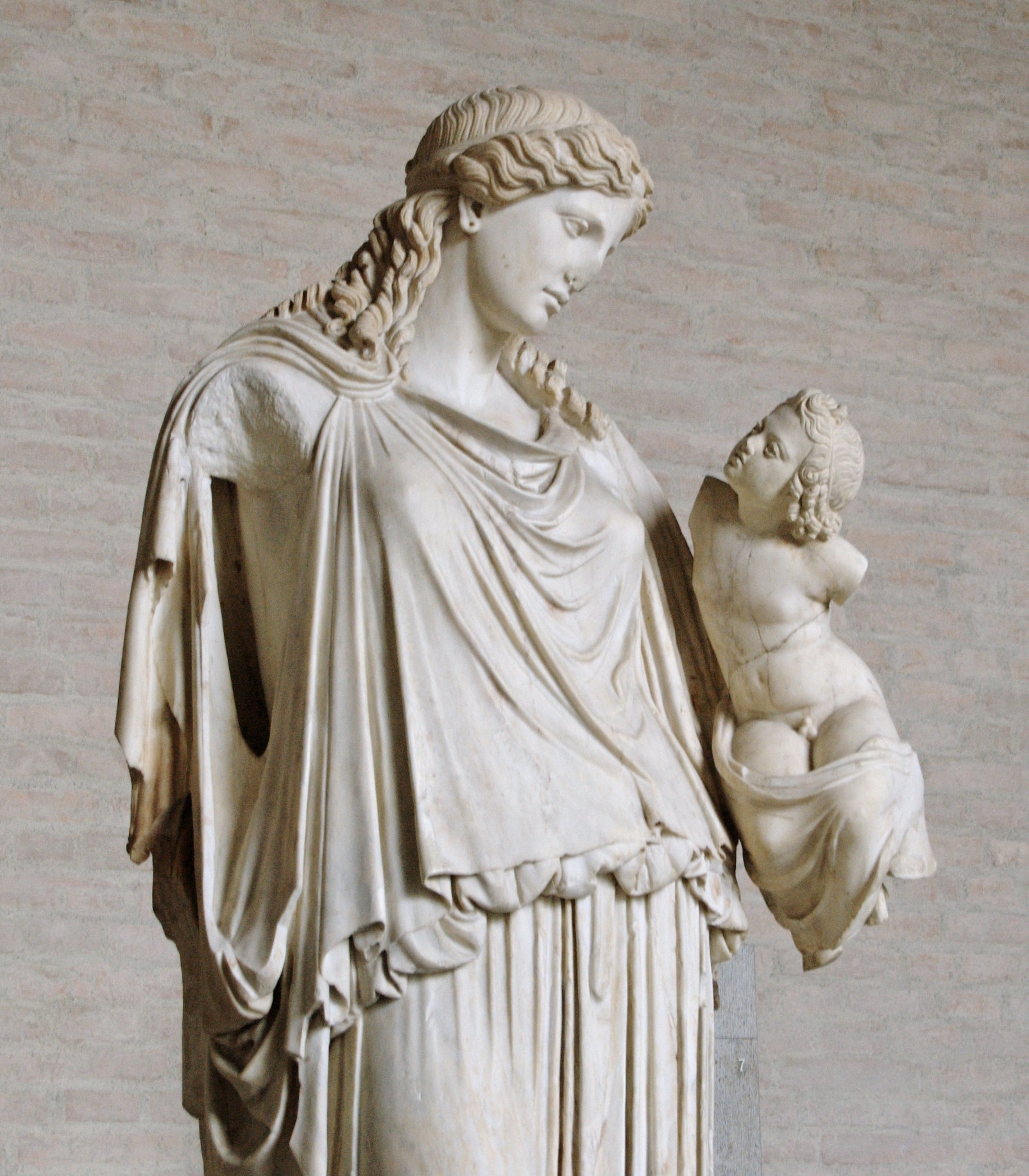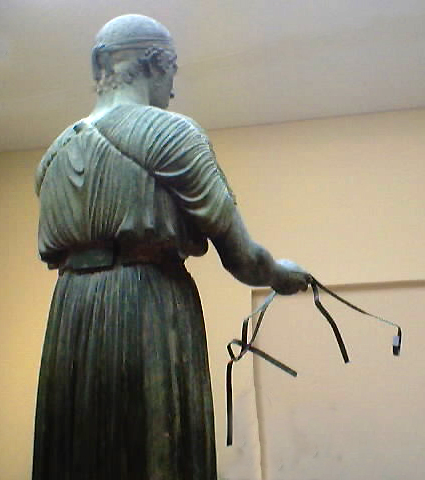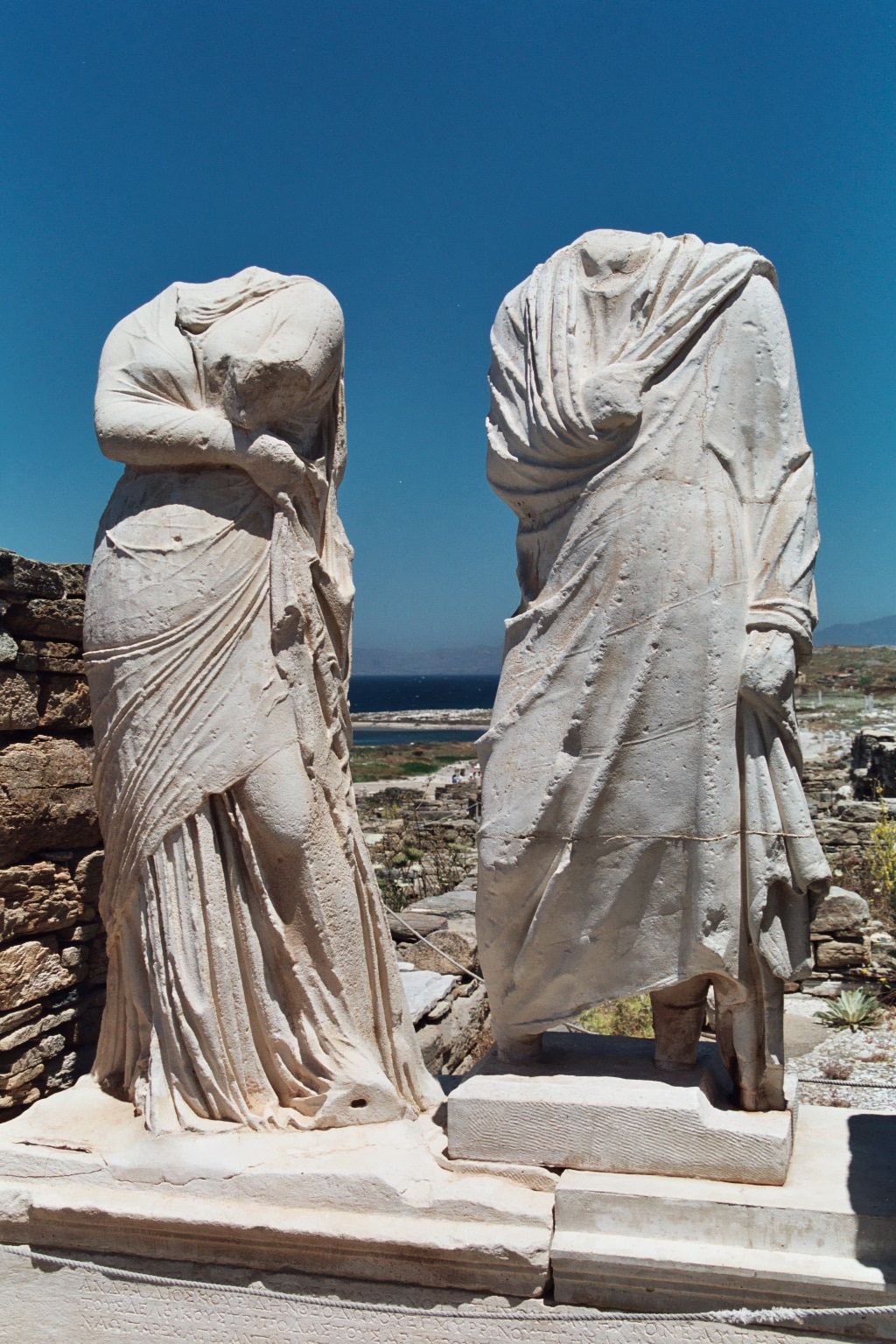|
Kolpos
The kolpos (Greek κόλπος, breast) is the ''blousing'' of a peplos, chiton or tunic in Ancient Greek clothing, whereby excess length of the material hangs folded over a zone (a narrow girdle). The fabric of the garment was typically cut longer than the shoulder-to-floor measurement of the women or man wearing it. The excess length was dealt with at the waist (creating the kolpos) and optionally the top edge (creating the apoptygma). To create the kolpos, a zone was tied around the body below the breast (high-girdled) or at the waist (low-girdled) and excess fabric was pulled up over it. The fabric fell over the girdle so as to hide it, and was often pulled longer in back than in front. This fold was the kolpos. A second (visible) zone could be tied over the kolpos to redefine the waist, high or low. This might be hidden again by the apoptygma, the loose, folded down top of the peplos. See also * Clothing in ancient Greece Clothing in ancient Greece primarily consisted ... [...More Info...] [...Related Items...] OR: [Wikipedia] [Google] [Baidu] |
Zone (vestment)
The zone ( el, ζώνη, ''zōnē'') is a form of girdle or belt common in the ancient eastern Mediterranean. The term occurs in Homer, for instance, as ( el, ζώνην, ''zonēn'') girdle and can also refer to the waist itself. Classical Greek had a verb ( el, ζώννυσθαι, ''zōnnysthai'') put a girdle around the loins, or "gird one's self." In modern Greek and Church Slavonic the zone or (Поясъ, ''poyas'' - ''belt'') is a liturgical belt worn as a vestment by priests and bishops of the Eastern Orthodox Church, Oriental Orthodox Churches and Eastern Catholic Churches. It is made of brocade with an embroidered or appliquéd cross in the center, with long ribbons at the ends for tying around the waist. It is worn over the sticharion and the epitrachelion and keeps them in place as the priest performs the Divine Liturgy. In this regard it is similar to the cincture of the Roman Catholic Church. The zone is not worn for services when the priest is not fully ves ... [...More Info...] [...Related Items...] OR: [Wikipedia] [Google] [Baidu] |
Eirene Ploutos Glyptothek Munich 219 N4
{{disambiguation, given name ...
Eirene may refer to: * Eirene (artist), 1st-century Greek artist * Eirene (daughter of Poseidon), in Greek mythology * ''Eirene'' (genus), a genus of hydrozoans in the family Eirenidae * Eirene (goddess), the Greek personification of peace * Eirene (moon), a moon of Jupiter * Eirene (''Rome'' character) * Eirene of Montferrat, Byzantine Empress consort * Eirene Mort (1879–1977), Australian artist and writer * Eirene White, Baroness White, (1909–1999), British politician See also * Irene (other) Irene is a name derived from εἰρήνη (eirēnē), the Greek for "peace". Irene, and related names, may refer to: * Irene (given name) Places * Irene, Gauteng, South Africa * Irene, South Dakota, United States * Irene, Texas, United States ... [...More Info...] [...Related Items...] OR: [Wikipedia] [Google] [Baidu] |
Peplos
A peplos ( el, ὁ πέπλος) is a body-length garment established as typical attire for women in ancient Greece by circa 500 BC, during the late Archaic and Classical period. It was a long, rectangular cloth with the top edge folded down about halfway, so that what was the top of the rectangle was now draped below the waist, and the bottom of the rectangle was at the ankle. One side of the peplos could be left open, or pinned or sewn together.Ancient Greek Dress ''Heilbrunn Timeline of Art History'', , 2000-2013. Retrieved 7 October 2013. In Latin and in a Roman context, it could be called a '' [...More Info...] [...Related Items...] OR: [Wikipedia] [Google] [Baidu] |
Chiton (costume)
A chiton (Greek: χιτών, ''khitōn'') is a form of tunic that fastens at the shoulder, worn by men and women of ancient Greece and Rome. There are two forms of chiton. One is the Doric chiton and the later Ionic chiton. According to Herodotus, popular legend was that Athenian women began to wear the chiton as opposed to the peplos after several women stabbed a messenger to death with the bronze pins characteristic of the peplos. Etymology The word ''chiton'' is derived from a Central Semitic language *''kittan'' (e.g. Hebrew כֻּתֹּנֶת ''kuttṓnĕṯ''), ultimately from a word for flax. Different forms and wearing styles A shorter version of the chiton was called the chitoniskos. Doric chiton The Doric chiton is a single rectangle of woolen or linen fabric. It can be worn plain or with an overfold called an ''apoptygma'', which is more common to women. It can be draped and fastened at the shoulder by pins (Greek: peronai; Latin: fibulae) or sewing, or by button ... [...More Info...] [...Related Items...] OR: [Wikipedia] [Google] [Baidu] |
Tunic
A tunic is a garment for the body, usually simple in style, reaching from the shoulders to a length somewhere between the hips and the knees. The name derives from the Latin ''tunica'', the basic garment worn by both men and women in Ancient Rome, which in turn was based on earlier Greek garments that covered wearers' waists. Ancient era Indian tunic Indus valley civilization figurines depict both women and men wearing a tunic-like garment. A terracotta model called Lady of the spiked throne depicts two standing turban-wearing men wearing what appears to be a conical gown marked by a dense series of thin vertical incisions that might suggest stiffened cloth. A similar gold disc in the al-Sabah Collection from the Kuwait National Museum appears to be from the Indus Valley civilization depicts similar conical tunic-wearing men holding two bulls by their tails under a pipal tree shown in an Indus-like mirror symmetry. A mother goddess figurine from the National Museum new Delhi ... [...More Info...] [...Related Items...] OR: [Wikipedia] [Google] [Baidu] |
Clothing In Ancient Greece
Clothing in ancient Greece primarily consisted of the chiton, peplos, himation, and chlamys. Ancient Greek civilians typically wore two pieces of clothing draped about the body: an undergarment ( : chitōn or : péplos) and a cloak ( : himátion or : chlamýs). Ancient Greek clothing was mainly based on necessity, function, materials, and protection rather than identity. Thus, clothes were quite simple, draped, loose-fitting and free-flowing. Customarily, clothing was homemade and cut to various lengths of rectangular linen or wool fabric with minimal cutting or sewing, and secured with ornamental clasps or pins, and a belt, or girdle (: zōnē). Pieces were generally interchangeable between men and women.Adkins, Lesley, and Roy Adkins. ''Handbook to Life in Ancient Greece.'' New York: Facts On File, 1997. Print. However, women usually wore their robes to their ankles while men generally wore theirs to their knees depending on the occasion and circumstance. While no clothes ... [...More Info...] [...Related Items...] OR: [Wikipedia] [Google] [Baidu] |
Greek Clothing
Clothing in ancient Greece primarily consisted of the chiton, peplos, himation, and chlamys. Ancient Greek civilians typically wore two pieces of clothing draped about the body: an undergarment ( : chitōn or : péplos) and a cloak ( : himátion or : chlamýs). Ancient Greek clothing was mainly based on necessity, function, materials, and protection rather than identity. Thus, clothes were quite simple, draped, loose-fitting and free-flowing. Customarily, clothing was homemade and cut to various lengths of rectangular linen or wool fabric with minimal cutting or sewing, and secured with ornamental clasps or pins, and a belt, or girdle (: zōnē). Pieces were generally interchangeable between men and women.Adkins, Lesley, and Roy Adkins. ''Handbook to Life in Ancient Greece.'' New York: Facts On File, 1997. Print. However, women usually wore their robes to their ankles while men generally wore theirs to their knees depending on the occasion and circumstance. While no clothes ... [...More Info...] [...Related Items...] OR: [Wikipedia] [Google] [Baidu] |





